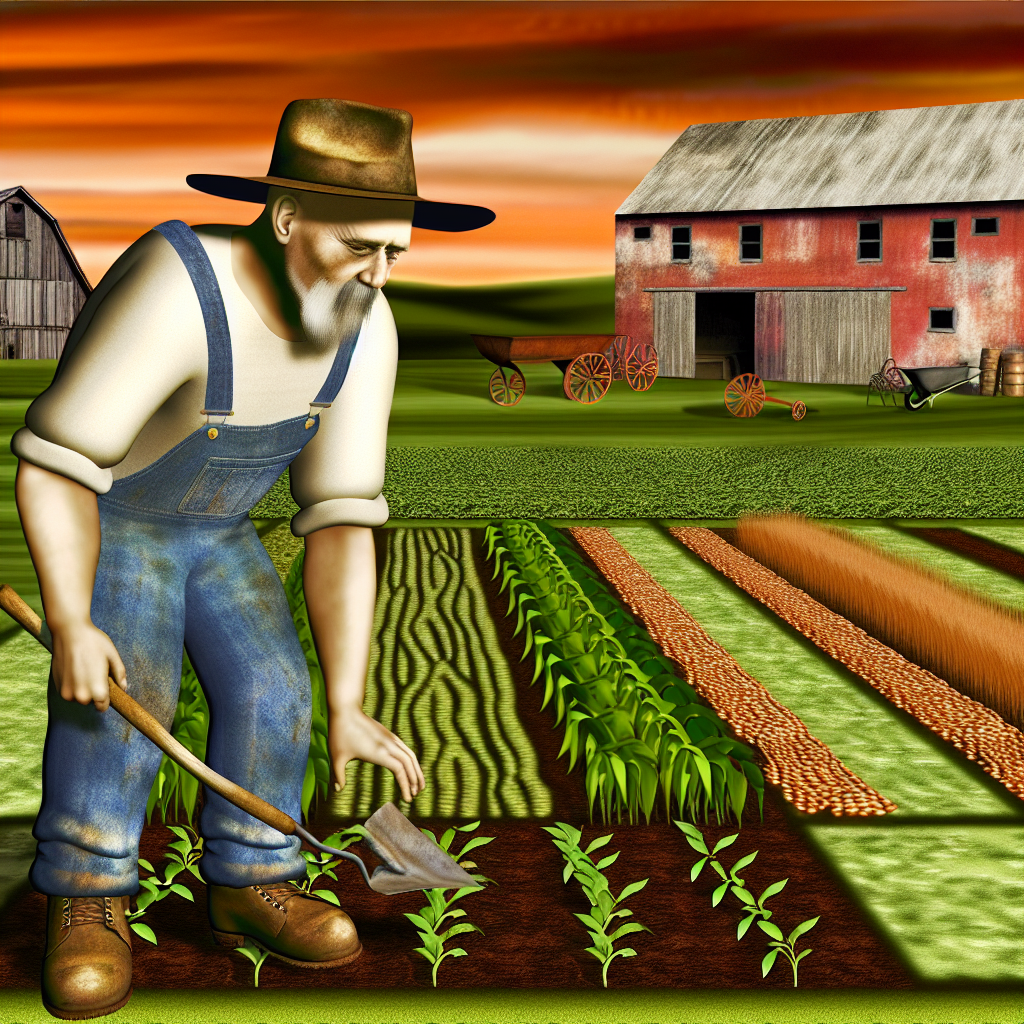Introduction to Crop Rotation
Definition of Crop Rotation
Crop rotation involves changing the type of crops grown in a specific area over time.
This practice prevents nutrient depletion in the soil.
Moreover, it helps manage pests and diseases naturally.
Importance of Crop Rotation
Implementing crop rotation enhances soil health significantly.
It also promotes biodiversity on the farm.
Rotating crops can lead to improved yields in subsequent seasons.
Farmers often notice reduced reliance on chemical fertilizers and pesticides.
Furthermore, crop rotation can mitigate soil erosion risks.
Healthy soil contributes to sustainable farming practices.
Strategies for Successful Crop Rotation
Farmers should plan rotation schedules based on crop families.
For example, legumes can enrich soil nitrogen levels.
Root crops can break up compacted soil and improve structure.
Moreover, integrating cover crops can further enhance soil quality.
Benefits of Plant Diversity
Diverse planting attracts various beneficial insects.
Additionally, it minimizes the risk of crop failure from pests.
Transform Your Agribusiness
Unlock your farm's potential with expert advice tailored to your needs. Get actionable steps that drive real results.
Get StartedPlant diversity can also enhance ecosystem resilience.
Utilizing different species can lead to a more balanced farm environment.
Benefits of Crop Rotation for Soil Health and Fertility
Enhancing Soil Structure
Crop rotation improves soil structure over time.
Diverse roots penetrate the soil at different depths.
This activity reduces compaction and promotes aeration.
Moreover, it encourages better water infiltration.
Boosting Soil Nutrients
Different crops contribute varied nutrients to the soil.
For instance, legumes fix nitrogen, enriching the soil.
Rotating these crops helps maintain nutrient balance.
As a result, farmers rely less on synthetic fertilizers.
Reducing Soil Erosion
Crops with deep roots help stabilize the soil.
The rotation minimizes erosion caused by wind and water.
This practice preserves valuable topsoil for future crops.
Consequently, it protects the land from degradation.
Controlling Pests and Diseases
Crop rotation disrupts pest life cycles effectively.
Many pests thrive on specific plants.
Changing crops can limit their food source.
Thus, it reduces the need for chemical pesticides.
Promoting Biodiversity
Incorporating a variety of crops enhances biodiversity.
This diversity supports beneficial insects and microorganisms.
Healthy ecosystems are crucial for pest management.
Additionally, they contribute to overall soil health.
Improving Crop Yields
Healthy soils lead to higher crop yields over time.
Rotating crops can improve growth conditions significantly.
Showcase Your Farming Business
Publish your professional farming services profile on our blog for a one-time fee of $200 and reach a dedicated audience of farmers and agribusiness owners.
Publish Your ProfileThis results in better resource utilization in fields.
Farmers notice gradual increases in productivity consistently.
Key Principles of Crop Diversity in Sustainable Farming
Enhancing Soil Health
Diverse crops improve soil structure and fertility.
They maintain a balance of nutrients in the soil.
Additionally, crop roots help prevent erosion.
This practice leads to healthier and more productive fields.
Pest and Disease Management
Crop diversity can disrupt pest and disease cycles.
Planting various species confuses pests and limits outbreaks.
Moreover, it reduces the need for chemical pesticides.
This approach fosters a more resilient farming system.
Improving Crop Yields
Diverse cropping systems offer higher yields over time.
Different plants can complement each other’s growth needs.
This leads to more efficient use of resources.
Farmers benefit from greater overall production.
Climate Resilience
Crop rotation and diversity enhance farms’ climate resilience.
This strategy enables adaptation to fluctuating weather patterns.
Diverse crops can absorb different amounts of water.
Thus, they reduce the risk of crop failures.
Community and Economic Benefits
Diverse farming systems support local economies.
They provide various products for markets and consumers.
Encouraging local sales strengthens community ties.
Ultimately, this leads to sustainable economic growth.
Explore Further: Sustainable Techniques to Increase Farm Biodiversity
Common Crop Rotation Systems and Their Applications
Benefits of Crop Rotation
Crop rotation enhances soil fertility and structure.
This practice reduces pest and disease buildup.
It also minimizes the need for chemical fertilizers.
Moreover, rotation supports diverse ecosystems.
Factors Influencing Crop Rotation Choices
Farmers consider soil type when selecting crops.
Climate conditions play a vital role in decision-making.
Market demand significantly influences crop selection.
Additionally, farmers assess their available resources.
Popular Crop Rotation Systems
One common system is the three-crop rotation.
This typically includes corn, soybeans, and wheat.
Next, farmers may use a four-crop rotation system.
This system can include legumes and cover crops.
Both systems improve nutrient cycling in soil.
Three-Crop Rotation
This system often features a cycle of corn, soybeans, and wheat.
Corn is grown in the first year.
In the second year, soybeans are planted.
Finally, wheat is cultivated in the third year.
Showcase Your Farming Business
Publish your professional farming services profile on our blog for a one-time fee of $200 and reach a dedicated audience of farmers and agribusiness owners.
Publish Your ProfileThis rotation enhances nitrogen fixation.
Four-Crop Rotation
A four-crop system might introduce a fourth crop like oats.
This added crop can improve soil organic matter.
Inclusion of cover crops further protects soil health.
Farmers may plant clover or rye as cover crops.
Integrated Pest Management in Rotation
Crop rotation aids in integrated pest management strategies.
Diverse crops disrupt pest life cycles.
This reduces reliance on pesticides over time.
Consequently, farmers experience lower pest populations.
Economic Considerations
Crop rotation can lead to cost savings for farmers.
It reduces the need for chemical inputs.
Higher yields from diverse cropping can increase profits.
Over time, sustainable practices improve farm resilience.
You Might Also Like: Benefits of Biodiversity in Modern Farming
Impact of Crop Rotation on Pest and Disease Management
Introduction to Crop Rotation
Crop rotation involves alternating crops in a specific sequence.
This practice enhances soil health and promotes biodiversity.
Additionally, it disrupts the lifecycles of pests and diseases.
Reduction of Soil-Borne Diseases
Planting different crops breaks disease cycles.
For instance, rotating legumes with cereals can disrupt root pathogens.
This approach reduces disease incidence significantly.
Pest Management through Crop Variation
Diverse crop rotations help manage pest populations effectively.
Certain pests are specific to particular crops.
By rotating plants, farmers can starve these pests of their food sources.
Impacts on Beneficial Insects
Crop diversity attracts a variety of beneficial insects.
These insects often prey on harmful pests.
For example, ladybugs can significantly decrease aphid populations.
Soy Nutrient Management
Different crops utilize various nutrients from the soil.
Changing crops can help replenish soil nutrients.
Cover crops, such as clover, fix nitrogen back into the soil.
Long-Term Sustainability
Crop rotation contributes to the long-term sustainability of farming.
It reduces reliance on chemical pesticides and fertilizers.
Farmers often observe healthier crops and improved yields.
Case Studies and Practical Applications
Many successful farms implement diverse crop rotation strategies.
For example, Green Valley Farms rotates corn and soybeans annually.
This has led to a noticeable decline in pest outbreaks.
Challenges and Considerations
Despite its benefits, implementing crop rotation can be challenging.
Farmers may face logistical issues with machinery and planting schedules.
Moreover, knowledge of crop compatibility is essential.
Delve into the Subject: How Crop Rotation Supports Sustainable Agriculture

Economic Advantages of Implementing Crop Rotation Practices
Improved Soil Health
Crop rotation enhances soil health significantly.
Showcase Your Farming Business
Publish your professional farming services profile on our blog for a one-time fee of $200 and reach a dedicated audience of farmers and agribusiness owners.
Publish Your ProfileIt improves soil structure and fertility over time.
This results in better nutrient availability for crops.
Healthy soils also retain moisture more effectively.
Increased Crop Yield
Farmers often notice higher yields through crop rotation.
Diverse crops contribute to a more balanced ecosystem.
This reduces pests and diseases among the crops.
Consequently, the overall output improves sustainably.
Cost Reduction
By rotating crops, farmers can lower their input costs.
This strategy helps reduce the reliance on chemical fertilizers.
It also minimizes expenses related to pest management.
Overall, reducing inputs increases profit margins.
Market Opportunities
Diverse crops open up new market avenues for farmers.
Farmers can participate in niche markets more effectively.
This increases profitability and reduces market saturation risks.
Resilience to Climate Variability
Crop rotation aids in building resilience against climate changes.
Diverse species can withstand fluctuating weather conditions better.
This strategy helps mitigate potential crop failures.
Gain More Insights: Sustainable Agriculture: Benefits of Diverse Crop Rotation
Challenges and Considerations in Crop Rotation Planning
Understanding Crop Needs
Each crop has unique nutrient requirements.
Farmers must understand these needs for effective rotation.
Failure to recognize this can lead to nutrient depletion.
Thus, farmers should conduct soil tests regularly.
This practice ensures that soil health is maintained.
Climate Variability
Climate conditions can impact crop rotation schedules.
For example, wet seasons may favor specific crops.
Conversely, dry periods can hinder planting decisions.
Farmers must remain flexible in their planning.
Adaptation is essential in response to changing weather patterns.
Pest and Disease Management
Crop rotation helps control pests and diseases.
However, it requires a keen understanding of pest cycles.
Some pests may thrive despite changing crops.
Effective communication with agronomists can provide insights.
An integrated pest management strategy enhances effectiveness.
Economic Constraints
Farmers often face financial limitations in crop rotation.
Initial investments in diverse crops can be high.
Yet, these can lead to long-term savings and benefits.
Farmers should consider potential yield improvements.
Assessing market demand for various crops is crucial.
Time and Labor Requirements
Crop rotation demands increased labor and management time.
Planning rotations can be complex and time-consuming.
Showcase Your Farming Business
Publish your professional farming services profile on our blog for a one-time fee of $200 and reach a dedicated audience of farmers and agribusiness owners.
Publish Your ProfileFarmers should evaluate their labor availability.
Utilizing technology can streamline the planning process.
Investing in training can enhance workforce efficiency.
Case Studies: Successful Crop Rotation and Diversity Examples
Improving Soil Health at Green Valley Farm
Green Valley Farm has successfully implemented a crop rotation strategy.
They rotate corn, soybeans, and cover crops annually.
This practice enhances soil health and fertility significantly.
Moreover, the farm experiences reduced pest pressures and disease prevalence.
The diverse cropping system promotes beneficial microbial activity in the soil.
Increased Yields at Maplewood Growers
Maplewood Growers adopted a diversified crop rotation plan.
They integrate vegetables, grains, and legumes in their fields.
This method led to improved yields and better-quality produce.
Additionally, it helped control weeds and stabilize the soil structure.
As a result, Maplewood has seen both economic and environmental benefits.
Enhancing Biodiversity with Riverbend Farms
Riverbend Farms focuses on enhancing biodiversity through rotation.
They plant a mix of crops including flowers, herbs, and staples.
This approach attracts a variety of pollinators and beneficial insects.
Furthermore, it improves ecosystem resilience against environmental stressors.
Riverbend has reported higher levels of biodiversity in their fields.
Economic Benefits of Crop Diversity at Oak Hill Distillers
Oak Hill Distillers pursued crop diversity to enhance profitability.
By rotating grains with specialty crops, they expanded their market reach.
They noted reduced input costs due to fewer pesticide applications.
This strategy resulted in increased revenue from specialty products.
Overall, it created a more sustainable and profitable farming system.
Additional Resources
The Three Sisters of Indigenous American Agriculture | National …
Agricultural Diversification: Practice and Policy – National …




